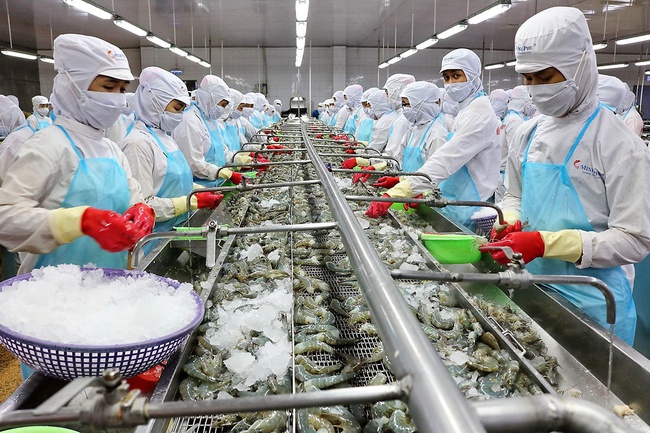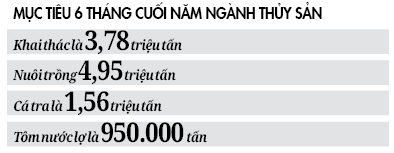- Read all
- Rice
- Fisheries
- Cassava
- Fertilizer & Pesticide
- Coffee
- Animal Feed
- Cocoa
- Seed
- Tea
- Wood
- Pepper
- Agricultural Cooperations
- Cashew
- Agricultural Investments
- Rubber
- Governmental Policies
- Sugarcane
- Agricultural Startup Ecosystem
- Corn
- Technological Innovations
- Spices
- Organic Agriculture
- Bean
- Food Manufacturing
- Fruit & Vegetable
- Agricultural Value Chain
- Flower
- Water & Waste Management
- Meat
- Processed Food
- Dairy
- Plant Originated Products
- General Agro Commodities
- Animal Originated Products
Seafood exports need to overcome many "barriers" to collect 10 billion USD in 2022
July 22, 2022
Many fishing boats lie ashore
According to VASEP, seafood enterprises are having to bear many costs leading to input costs for enterprises' production, high product prices, directly affecting the competitiveness of seafood products. and industries.
From 2020 to now, with many reasons such as "port congestion" due to the Covid-19 pandemic and now the increase in gasoline fuel prices, it is already difficult to place containers, the freight rates at most routes have increased 4- 4 5 times.
As of June 2022, although it has decreased a bit, but to export a 40-foot container across the East Coast of the United States (Florida), the freight rate was about 16,400USD/cont, including the cost of road transportation. From factories in provinces to Ho Chi Minh City (accounting for more than 60%), the average is 400-410 million VND/cont.
According to VASEP's assessment, in the last 6 months of 2022, Vietnam's seafood industry will face many challenges from high gasoline prices and processing materials. Photo: VASEP
Ms. Ta Thi Ha said that the procedures for certifying the origin of exploited aquatic products are still inadequate. Therefore, enterprises still have problems when using certified raw materials. Besides, the EU has not yet removed the IUU yellow card for Vietnamese seafood, which will be challenges for the seafood industry in the last 6 months of 2022.
After 12 increases in petrol prices since the beginning of the year, now 40-50% of fishing vessels are ashore. Input materials for processing factories decreased by 70-80% compared to before.
According to statistics of Hon Ro fishing port (Khanh Hoa), by July 2022, more than 90% of fishing boats that were not supported with fuel costs had stopped operating. The volume of seafood arriving at the port also decreased by 30-40%, mainly from short-term fishing vessels. Due to a sharp decrease in domestic raw materials, seafood processing factories also face difficulties. Enterprises are forced to increase the source of imported materials but not enough for processing.
The increase in petrol prices also pushes up road transport and logistics costs by 10-20% compared to before. "This is a difficult problem for seafood enterprises in the context that the world seafood market has recovered after Covid-19 and rival supply sources are increasing fierce competition" - Ms. Ta Thi Ha - expert pangasius market of VASEP said.
According to Ms. Ha, the challenge of raw materials for processing will also be a barrier for Vietnamese seafood exporters in the last months of the year. Currently, raw materials from farming account for 70% of raw materials for export processing. Therefore, enterprises have the need to expand concentrated farming areas to increase raw materials for export processing.
However, at present, localities are urbanizing, so changes in land planning for production and land use plans are a big challenge for seafood enterprises and aquaculture farmers. In addition, policies to encourage the import of aquatic materials for production and export are still lacking, and the procedures for import are still difficult and entangled.
Speeding up the "harvesting" of USD 9 billion in seafood exports
Seafood exports in June 2022 brought in over 1 billion USD in foreign currency, equivalent to May 2022 and up 23% over the same period last year.
With the above results, in the first 6 months of 2022, Vietnam's seafood exports are estimated at nearly 5.8 billion USD, up 40% compared to the first half of 2021.
In which, shrimp and pangasius exports are still the two main products, export turnover in the first 6 months of the year reached over 2.3 and 1.4 billion USD respectively.
In the last 6 months of 2022, the seafood industry strives for a total output of 8.73 million tons. In which, the exploitation output is 3.78 million tons; aquaculture output 4.95 million tons. Pangasius output is 1.56 million tons; brackish water shrimp is 950,000 tons. Export turnover is 9 billion USD.
For pangasius exports, at a conference held by VASEP at the end of June, Ms. Truong Thi Tuyet Hoa - a member of the Board of Directors of Vinh Hoan Joint Stock Company, highlighted the challenges in the last 6 months of this year for the industry. This item is lack of raw material and cost increase. The "golden" opportunity of pangasius is still there when it has the ability to replace pollock (in the same segment of white fish) in Europe and the US while this fish supply is affected by the Russia-Ukraine conflict.
"We want the authorities to step up negotiations to remove the fact that the US Food Safety and Inspection Service (FSIS) has not yet approved this item," Ms. Hoa said.
According to Mr. Tran Dinh Luan - Director General of the Directorate of Fisheries, the seafood industry had record export results in the first months of the year thanks to good market forecasts, so it took the initiative in raw materials and took advantage of export opportunities. However, the reality also arises new problems related to increased costs and the risk of shortage of raw materials at the end of the year.
"The Ministry of Agriculture and Rural Development has worked with associations and commodity industries to evaluate and recommend farmers and businesses to take advantage of production opportunities and control costs to maintain profits. The current solution is to limit intermediaries and use raw materials. domestic raw materials to replace a part of imported materials" - Mr. Luan noted.
Source: Binh Minh - danviet.vn
Related news
-
ASEAN cooperates on digitalization in aid of rural development
In rural regions, digitalization and technological innovation present both benefits and obstacles.September 5, 2022 -
Newspaper print number 211, out today October 24, 2022
News of agriculture, farmers and rural areas featured in Vietnam Agriculture newspaper No. 211 today 24/10/2022.October 24, 2022 -
Farmers develop economic from a seedless fruit
Bao Lam seedless persimmon brings high economic efficiency to the people and is a famous specialty fruit with its distinctive flavor of Lang Son province.October 19, 2022 -
Opportunities for Long An agricultural products to enter the Korean market
Long An province invites Korean businesses to continue investing in the agricultural product processing industry, logistics, health, beauty and importing dragon fruit products, lemons, bananas, rice...August 30, 2022 -
Farmers overcome the 'supplies price storm' with the No. 7 Hana rice variety
In the summer-autumn crop of 2022, the price of materials has increased. However, thanks to the production associated with the enterprise, along with the good harvest of Hana No. 7 rice variety, farmers have overcome difficulties.August 29, 2022
Events See more

Vietnamplas 2022 - Vietnam International Plastic and Rubber Industry Exhibition
23-03-2023 - 26-11-2022 09:00 - 17:00
Saigon Exhibition and Convention Center (SECC) – 799 Nguyen Van Linh Boulevard, District 7, City. Ho Chi Minh.

GROWTECH EXPO - FLORAPLANTEXPO 2021
02 - 05-11-2022 09:00 - 17:00
Saigon Exhibition and Convention Center (SECC) – 799 Nguyen Van Linh Boulevard, District 7, City. Ho Chi Minh.

VTG 2022
18 - 25-10-2022 09:00 - 17:00
Saigon Exhibition and Convention Center (SECC) – 799 Nguyen Van Linh Boulevard, District 7, City. Ho Chi Minh.

VIETSTOCK 2022 - SPECIALISED EXHIBITION OF LIVESTOCK, FEED AND MEAT PROCESSING IN VIETNAM
12 - 14-10-2022 08:00 - 17:00
799 Nguyen Van Linh, Tan Phu Ward, Dist. 7, Hochiminh City, Vietnam

VTG 2022
21 - 27-09-2022 09:00 - 17:00
Saigon Exhibition and Convention Center (SECC) – 799 Nguyen Van Linh Boulevard, District 7, City. Ho Chi Minh.
.png)
VIETFISH 2022
22 - 26-08-2022 09:00 - 17:00
Saigon Exhibition and Convention Center (SECC) – 799 Nguyen Van Linh Boulevard, District 7, City. Ho Chi Minh.
Business Opportunities See more
-
BURANI INTERFOOD is looking for Buyers in Vietnam
Type:
November 22, 2021
-
BURANI INTERFOOD is looking for Buyers in Vietnam
Type: Wholesaling Meat
November 22, 2021
-
BURANI INTERFOOD is looking for Buyers in Vietnam
Type: Wholesaling Meat
November 22, 2021
-
BURANI INTERFOOD is looking for Buyers in Vietnam
Type: Wholesaling Meat
November 19, 2021
-
BURANI INTERFOOD is looking for Buyers in Vietnam
Type:
November 19, 2021
-
Indian purchaser looking for high quality cashew nut kernel from Vietnam
Type: Exporting Cashew
Mar 14, 2016
534
Limitless database of qualified and verified agricultural partners
124
Exclusive buy & sell leads on specific agricultural commodities
24
Agricultural events in Vietnam and Asia Pacific region
Stay informed!
Enter your email address below to receive updates each time we publishes new content


